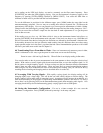4
2. DESCRIPTION OF THE HP3586
2.1 General – For those not familiar with selective level meters they can best be visualized as a receiver
having very high selectivity with a detector system capable of accurately measuring low power signal
levels from +20dbm down to –100dbm and frequency over a wide range from 200Hz to 32MHz and. It
also will output a signal of 0dbm, one miliwatt, at exactly the same frequency that the instrument is tuned
to, which is usually the center frequency of the selected receiver band pass filter. It’s also a SSB receiver
to aid in tuning the signal to be measured. Because of these features a selective level meter is extremely
valuable for measuring and the analysis of audio up through RF signals, it’s a whole lab of instruments in
one package. Because of this it can be used to measure the performance of electronic radio and RF
circuits, measure the strength and frequency of radio signals along with driving other electronic devices
using it’s one miliwatt low distortion output signal as a low power signal generator.
The HP3586 family of selective level meters was designed to measures signal levels and frequency in
selected portions of its total frequency spectrum on multiplex telephone transmission lines. These
frequency slices can be operator set by selection of filters from 20 Hz up to 3100 Hz in bandwidth that are
front panel selectable. All versions will have 20 and 400 Hz filters. The A and B versions have one
additional 1740 or 2000 Hz filter depending on model. Those with 003 option will have a 3100Hz filter
and a noise weighting WTD filter that can be switched in series with the 3100Hz filter to reduce low and
high audio frequency noise. The C version only has the 3100Hz filter without a WTD noise filter and no
filter options.
There are three versions of this family of instruments. The A and B versions have modes and features
making it easier to measure SSB channels on phone lines. The C version is more basic and doesn’t have
the SSB channel features of the A and B versions. However all three will work equally well for most of
the RF and audio measurement described in this document.
In its measuring modes except wideband the instrument will display and output a 0 dbm signal to a rear
panel connector at the center frequency its filter from an internal tracking oscillator. This signal’s
frequency can be set using the front panel keyboard or tuning knob. It also has a counter system that can
be commanded to read and display the frequency of the strongest steady signal within its filter’s pass band.
It can then be commanded to store this frequency in its frequency register changing its center frequency to
the register’s frequency and outputting this new frequency to its rear panel Fo connector. This feature is
very useful for measuring the frequency of a carrier and then synchronizing the frequency of another
device to that frequency. The instrument also contains a SSB detector system that is used to receive and
tune SSB signals or other signals into the instruments pass band.
In the following chapters I’ll describe how to setup your HP3586 to do useful measurements of frequency,
power, voltage, network analysis, distortion analysis, and use it on the air as an accurate signal strength
meter along with using it as a VFO to control an AM transmitter. In the interest of keeping things simple,
instrument features and modes that I feel are not useful for RF or audio measurements will not be discussed
in this document.
2.2 Instrument Capabilities - Since the HP3586 measures the total power of all signals in its filter’s
pass band, its always best to use the narrowest possible filter when measuring narrow band signals to
reduce noise errors. Power measurements are usually displayed in db’s referenced to one miliwatt, dbm
units, but can also be referenced to a pico watt, which I haven’t found useful. It can also measure the
voltage of a signal in db’s referenced to .775 volts on all versions and 1 volt on the C version. These units
may seem cumbersome since most of us prefer dealing with linear measurements in watts and volts, but it’s
better suited for measuring over very large ranges and is a standard method for those working with
telecommunications systems. If you are not familiar with this system of measurement or a little hazy on
understanding it, please take a look at Appendix A for a better understanding. You can easily convert to
watts or volts from the HP3586 panel readings by using the following formulas and a hand held calculator:


















